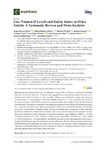Mostrar o rexistro simple do ítem
Low Vitamin D Levels and Frailty Status in Older Adults: a Systematic Review and Meta-Analysis
| dc.contributor.author | Marcos-Pérez, Diego | |
| dc.contributor.author | Sánchez-Flores, María | |
| dc.contributor.author | Bonassi, Stefano | |
| dc.contributor.author | Costa, Solange | |
| dc.contributor.author | Teixeira, João | |
| dc.contributor.author | Fernández-Tajes, Juan | |
| dc.contributor.author | Pásaro, Eduardo | |
| dc.contributor.author | Valdiglesias, Vanessa | |
| dc.contributor.author | Laffon, Blanca | |
| dc.date.accessioned | 2020-09-29T11:25:45Z | |
| dc.date.available | 2020-09-29T11:25:45Z | |
| dc.date.issued | 2020 | |
| dc.identifier.citation | Marcos-Pérez, D.; Sánchez-Flores, M.; Proietti, S.; Bonassi, S.; Costa, S.; Teixeira, J.P.; Fernández-Tajes, J.; Pásaro, E.; Valdiglesias, V.; Laffon, B. Low Vitamin D Levels and Frailty Status in Older Adults: A Systematic Review and Meta-Analysis. Nutrients 2020, 12, 2286. https://doi.org/10.3390/nu12082286 | es_ES |
| dc.identifier.uri | http://hdl.handle.net/2183/26255 | |
| dc.description.abstract | [Abstract] Serum vitamin D deficiency is widespread among older adults and is a potential modifiable risk factor for frailty. Moreover, frailty has been suggested as an intermediate step in the association between low levels of vitamin D and mortality. Hence, we conducted a systematic review of the literature and meta-analysis to test the possible association of low concentrations of serum 25-hydroxyvitamin D (25(OH)D), a marker of vitamin D status, with frailty in later life. We reviewed cross-sectional or longitudinal studies evaluating populations of older adults and identifying frailty by a currently validated scale. Meta-analyses were restricted to cross-sectional data from studies using Fried’s phenotype to identify frailty. Twenty-six studies were considered in the qualitative synthesis, and thirteen studies were included in the meta-analyses. Quantitative analyses showed significant differences in the comparisons of frail (standardized mean difference (SMD)—1.31, 95% confidence interval (CI) (−2.47, −0.15), p = 0.0271) and pre-frail (SMD—0.79, 95% CI (−1.58, −0.003), p = 0.0491) subjects vs. non-frail subjects. Sensitivity analyses reduced heterogeneity, resulting in a smaller but still highly significant between-groups difference. Results obtained indicate that lower 25(OH)D levels are significantly associated with increasing frailty severity. Future challenges include interventional studies testing the possible benefits of vitamin D supplementation in older adults to prevent/palliate frailty and its associated outcomes. | es_ES |
| dc.description.sponsorship | This research was funded by Xunta de Galicia [ED431B 2019/02]; Ministerio de Educación, Cultura y Deporte [BEAGAL18/00142 to V.V, PRX19/00353 to B.L.]; and Deputación Provincial de A Coruña [to D.M.-P. and M.S.-F.] | es_ES |
| dc.description.sponsorship | Xunta de Galicia; ED431B 2019/02 | |
| dc.language.iso | eng | es_ES |
| dc.relation | info:eu-repo/grantAgreement/MICINN/Plan Estatal de Investigación Científica y Técnica y de Innovación 2017-2020/BEAGAL18%2F00142/ES/ | |
| dc.relation | info:eu-repo/grantAgreement/MICINN/Plan Estatal de Investigación Científica y Técnica y de Innovación 2017-2020/PRX19%2F00353/ES/ | |
| dc.relation.uri | https://doi.org/10.3390/nu12082286 | es_ES |
| dc.rights | Atribución 4.0 Internacional | es_ES |
| dc.rights.uri | http://creativecommons.org/licenses/by/4.0/ | * |
| dc.subject | Frailty | es_ES |
| dc.subject | Meta-analysis | es_ES |
| dc.subject | Older adults | es_ES |
| dc.subject | Systematic review | es_ES |
| dc.subject | Vitamin D | es_ES |
| dc.title | Low Vitamin D Levels and Frailty Status in Older Adults: a Systematic Review and Meta-Analysis | es_ES |
| dc.type | info:eu-repo/semantics/article | es_ES |
| dc.rights.access | info:eu-repo/semantics/openAccess | es_ES |
| UDC.journalTitle | Nutrients | es_ES |
| UDC.volume | 12 | es_ES |
| UDC.issue | 8 | es_ES |
| UDC.startPage | 2286 | es_ES |
| dc.identifier.doi | 10.3390/nu12082286 |






